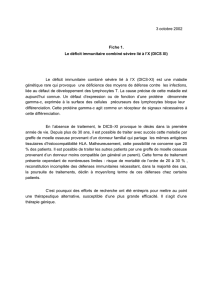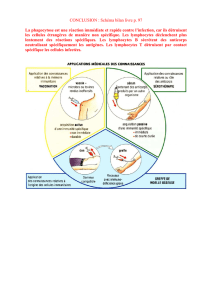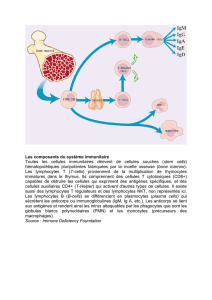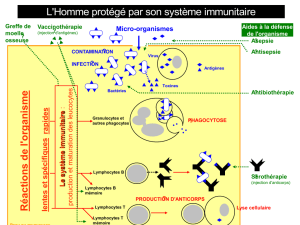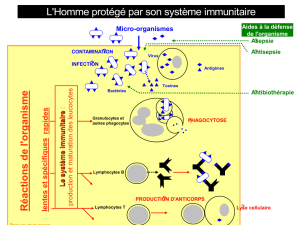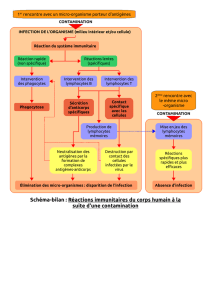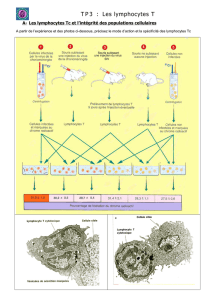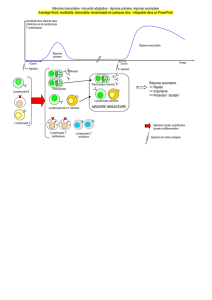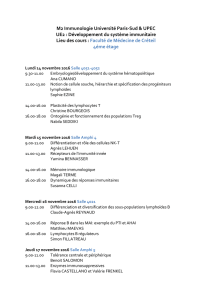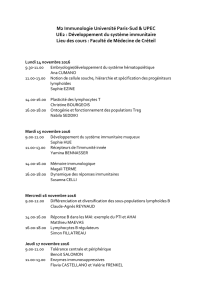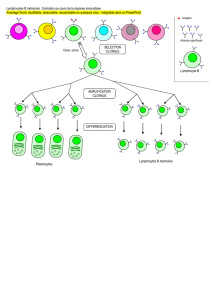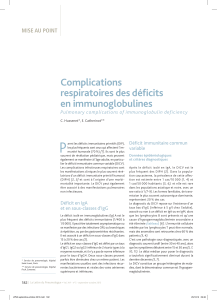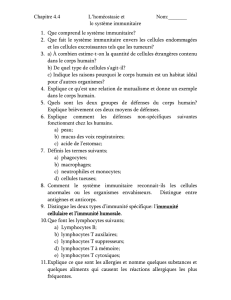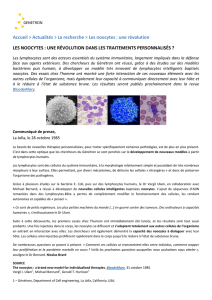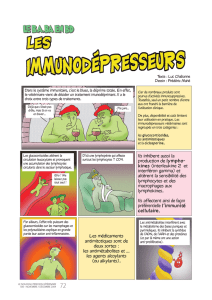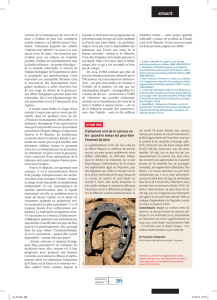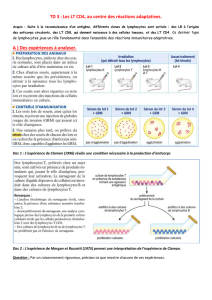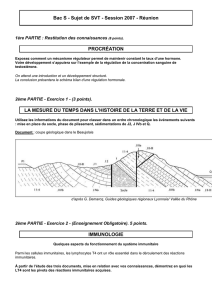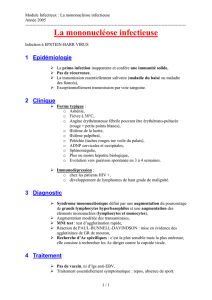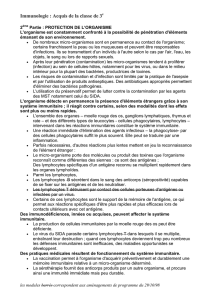Tests de prolifération lymphocytaire : indications et prescription
publicité
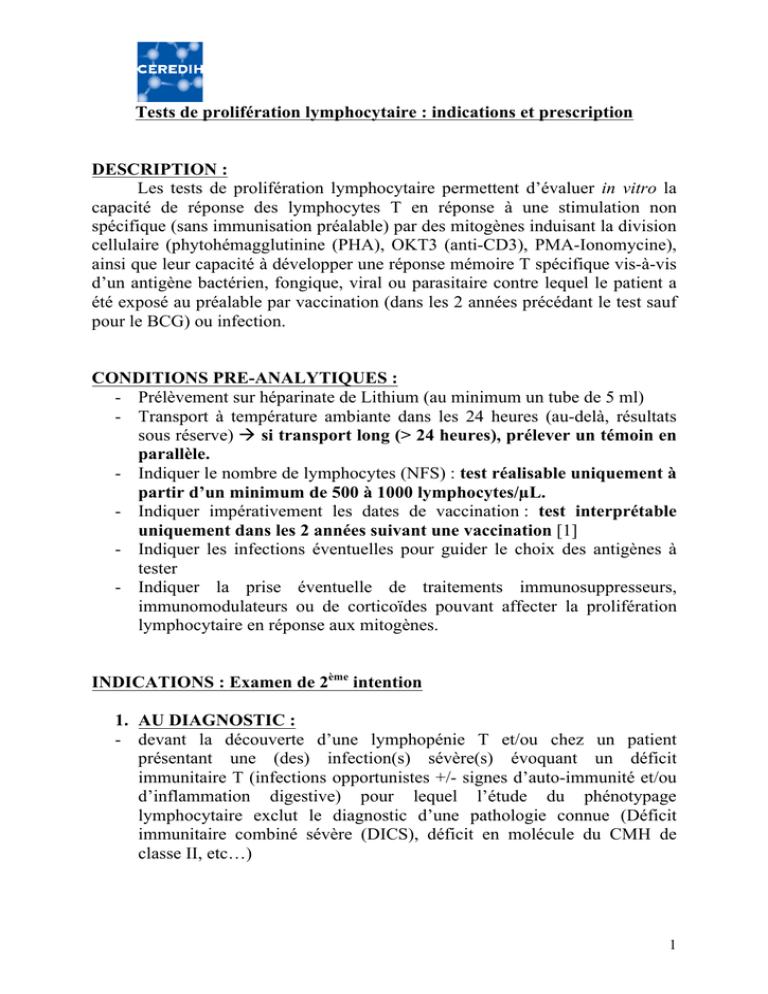
Tests de prolifération lymphocytaire : indications et prescription DESCRIPTION : Les tests de prolifération lymphocytaire permettent d’évaluer in vitro la capacité de réponse des lymphocytes T en réponse à une stimulation non spécifique (sans immunisation préalable) par des mitogènes induisant la division cellulaire (phytohémagglutinine (PHA), OKT3 (anti-CD3), PMA-Ionomycine), ainsi que leur capacité à développer une réponse mémoire T spécifique vis-à-vis d’un antigène bactérien, fongique, viral ou parasitaire contre lequel le patient a été exposé au préalable par vaccination (dans les 2 années précédant le test sauf pour le BCG) ou infection. CONDITIONS PRE-ANALYTIQUES : - Prélèvement sur héparinate de Lithium (au minimum un tube de 5 ml) - Transport à température ambiante dans les 24 heures (au-delà, résultats sous réserve) à si transport long (> 24 heures), prélever un témoin en parallèle. - Indiquer le nombre de lymphocytes (NFS) : test réalisable uniquement à partir d’un minimum de 500 à 1000 lymphocytes/µL. - Indiquer impérativement les dates de vaccination : test interprétable uniquement dans les 2 années suivant une vaccination [1] - Indiquer les infections éventuelles pour guider le choix des antigènes à tester - Indiquer la prise éventuelle de traitements immunosuppresseurs, immunomodulateurs ou de corticoïdes pouvant affecter la prolifération lymphocytaire en réponse aux mitogènes. INDICATIONS : Examen de 2ème intention 1. AU DIAGNOSTIC : - devant la découverte d’une lymphopénie T et/ou chez un patient présentant une (des) infection(s) sévère(s) évoquant un déficit immunitaire T (infections opportunistes +/- signes d’auto-immunité et/ou d’inflammation digestive) pour lequel l’étude du phénotypage lymphocytaire exclut le diagnostic d’une pathologie connue (Déficit immunitaire combiné sévère (DICS), déficit en molécule du CMH de classe II, etc…) 1 - chez un patient suspect/atteint de (uniquement à partir d’un de 500 à 1000 lymphocytes/µL) : TTL Type de Déficit Immunitaire PMA PHA OKT3 Héréditaire -Iono DICs avec nombre de - ou ↓↓↓ lymphocytes > 500/µL Syndrome d’Omenn - ou ↓↓ minimum Ag Réf. - [2] - ou ↓↓ N N ou ↓ [2] Déficit en ZAP70 - ou ↓↓↓ - ou ↓↓↓ N Déficit en CD8A N N N Déficit en RMRP ↓↓ N ou ↓ N ou ↓ OKT3 : - ou ↓↓↓ OKT3+CD28 : - ou ↓ OKT3+CD28+IL-2 : N [6-7] N ou ↓ OKT3+CD28 : ↓↓ [8] N OKT3+CD28 : ↓ [9] ↓ ou ↓↓↓ OKT3 : ↓ ou ↓↓↓ OKT3+IL-2 : ↓ ↓↓↓ ↓↓↓ Déficit en IKBKB Déficit dans le complexe CARD11BCL10-MALT1 (CBM) Déficit en ITK Défauts du flux calcique (ORAI1, STIM1) Déficit en PNP Défaut d’expression du CMH de classe II (CIITA, RFX5, RFXA, RFXANK) Déficit en FOXN1 Déficit en CORO1A Déficit en CD40 et CD40L Syndrome de DiGeorge avec lymphopénie et diminution du % de cellules T naïves Syndrome de DiGeorge avec N ↓ ou ↓↓↓ [3] [4] [5] - [10] ↓↓↓ [11] - [12] - ou ↓↓↓ ↓↓ N N N ou ↓ N ou ↓ [13] [14] [1516] Pas de 2 nombre normal de lymphocytes TTL 2. EN SUIVI D’UNE GREFFE DE CELLULES SOUCHES HEMATOPOÏETIQUES OU DE THERAPIE GENIQUE : Chez des patients ayant subi une greffe de cellules souches hématopoïétiques ou une thérapie génique afin d’évaluer la reconstitution des fonctions lymphocytaires T : o A partir de 1000 lymphocytes/µL à TTL PHA o Si réponse positive à la PHA à revacciner le patient selon les recommandations (i.e. pas de vaccin vivant atténué) et tester 1 mois après la 3ème injection la réponse aux antigènes vaccinaux o Si réponse positive aux antigènes à STOP ** ** La prescription de nouvelles TTL peut être discutée au cas par cas dans le suivi post-greffe des enfants atteints initialement d’un DICS (déficit immunitaire combiné sévère) ou de certains DICs (déficits immunitaires combinés) 1. 2. 3. 4. 5. 6. F Le Deist: Comment explorer un déficit immunitaire ? Arch Pediatr 2003, 10 Suppl 4:510s-512s. WT Shearer, E Dunn, LD Notarangelo, CC Dvorak, JM Puck, BR Logan, LM Griffith, DB Kohn, RJ O'Reilly, TA Fleisher, et al: Establishing diagnostic criteria for severe combined immunodeficiency disease (SCID), leaky SCID, and Omenn syndrome: the Primary Immune Deficiency Treatment Consortium experience. J Allergy Clin Immunol 2014, 133:1092-8. ME Elder: SCID due to ZAP-70 deficiency. J Pediatr Hematol Oncol 1997, 19:54650. T Espanol, E Mancebo: CD8 deficiency. In: Primary immunodeficiency diseases: a molecular and genetic approach, 3rd ed. pp. 274-8: Oxford University Press; 2014: 274-8. FD Kavadas, S Giliani, Y Gu, E Mazzolari, A Bates, E Pegoiani, CM Roifman, LD Notarangelo: Variability of clinical and laboratory features among patients with ribonuclease mitochondrial RNA processing endoribonuclease gene mutations. J Allergy Clin Immunol 2008, 122:1178-84. U Pannicke, B Baumann, S Fuchs, P Henneke, A Rensing-Ehl, M Rizzi, A Janda, K Hese, M Schlesier, K Holzmann, et al: Deficiency of innate and acquired immunity caused by an IKBKB mutation. N Engl J Med 2013, 369:2504-14. 3 7. 8. 9. 10. 11. 12. 13. 14. 15. 16. C Nielsen, MA Jakobsen, MJ Larsen, AC Muller, S Hansen, ST Lillevang, N Fisker, T Barington: Immunodeficiency Associated with a Nonsense Mutation of IKBKB. J Clin Immunol 2014, 34:916-21. SE Turvey, A Durandy, A Fischer, SY Fung, RS Geha, A Gewies, T Giese, J Greil, B Keller, ML McKinnon, et al: The CARD11-BCL10-MALT1 (CBM) signalosome complex: Stepping into the limelight of human primary immunodeficiency. J Allergy Clin Immunol 2014, 134:276-84. NK Serwas, D Cagdas, SA Ban, K Bienemann, E Salzer, I Tezcan, A Borkhardt, O Sanal, K Boztug: Identification of ITK deficiency as a novel genetic cause of idiopathic CD4+ T-cell lymphopenia. Blood 2014, 124:655-7. C Picard, CA McCarl, A Papolos, S Khalil, K Luthy, C Hivroz, F LeDeist, F RieuxLaucat, G Rechavi, A Rao, et al: STIM1 mutation associated with a syndrome of immunodeficiency and autoimmunity. N Engl J Med 2009, 360:1971-80. R Somech, A Lev, AJ Simon, S Hanna, A Etzioni: T- and B-cell defects in a novel purine nucleoside phosphorylase mutation. J Allergy Clin Immunol 2012, 130:53942. W Reith, C Picard, A Fisher: Molecular basis of MHC class II deficiency. In: Primary immunodeficiency diseases: a molecular and genetic approach, 3rd ed. pp. 241-57: Oxford University Press; 2014: 241-57. C Pignata, A Fusco, S Amorosi: Deficiency of FOXN1. In: Primary immunodeficiecy diseases: a molecular and genetic approach, 3rd ed. pp. 286-90: Oxford University Press; 2014: 286-90. LR Shiow, K Paris, JM Puck: Severe combined immunodeficiency due to absent Coronin-1A. In: Primary immunodeficiency diseases: a molecular and genetic approach, 3rd ed. pp. 294-6: Oxford University Press; 2014: 294-6. LD Notarangelo, S Giliani, A Plebani: CD40 and CD40 Ligand deficiencies. In: Primary immunodeficiency diseases: a molecular and genetic approach, 3rd ed. pp. 324-42: Oxford University Press; 2014: 324-42. R Ameratunga, HM Lederman, KE Sullivan, HD Ochs, K Seyama, JK French, R Prestidge, J Marbrook, WC Fanslow, JA Winkelstein: Defective antigen-induced lymphocyte proliferation in the X-linked hyper-IgM syndrome. J Pediatr 1997, 131:147-50. 4

